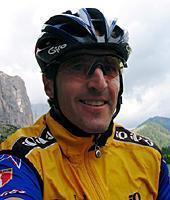
Recently on Cyclingnews.com |
91st Tour de France - July 3-25, 2004
 |
Davis Phinney's Tour Diary: A Sprinter's Tale
With over 300 national and international victories in a career that spanned two decades, Davis Phinney is still the winningest cyclist in U.S. history. In 1986, he was the first American ever to win a road stage in the Tour de France; five years later, he won the coveted USPRO road title in Philadelphia.
 In
2000, when Davis was just 40 years old, he was diagnosed with early-onset Parkinson's
disease. But that hasn't kept him down. Since retiring from professional cycling,
Davis has been a cycling sports commentator, public speaker and journalist.
He brings his passion for those two-wheeled machines to Cyclingnews for
the 2004 Tour de France.
In
2000, when Davis was just 40 years old, he was diagnosed with early-onset Parkinson's
disease. But that hasn't kept him down. Since retiring from professional cycling,
Davis has been a cycling sports commentator, public speaker and journalist.
He brings his passion for those two-wheeled machines to Cyclingnews for
the 2004 Tour de France.
Stage 12 - July 16: Castelsarrasin - La Mongie, 197.5 km
Regaining perspective - from a 10 year-old
Shouts of "Venga Venga" greet every movement by the Euskaltel riders here in the heart of the Pyrenees. It's as much Basque country as it is French and you can feel it as well as hear it. From our vantage point, upstairs in Restaurant La Choucas just 50 meters below the finish line, I feel lucky, thanks to Alex Stieda's acumen for organizing an indoor lunch for his group on this day when severe thunder showers are rolling through these ancient mountains.
The Tourmalet is a legendary climb, having been ridden by every great rider since the beginning of the Tour de France. The Tourmalet for me was always an intermediate climb en route to Luz Ardiden or super Bagneres. Some years were better (easier) than others, not depending on the direction even though climbing up from the north side is more difficult, but from how tired my legs felt and how far we were into the race.
The last time I did this climb, the race included not only today's climbs of the Col d'Aspin and the Tourmalet but also the Peyresourde and the finish to Luz Ardiden. On that day, I was especially struggling and was dropped from the gruppetto on the Aspin. Sean Yates stayed with me and paced me to the top, which we crested four minutes behind the group.
Like a man possessed, Sean absolutely railed the descent. I hung on for all I was worth, sliding sideways on the numerous switchbacks due to the softening tar from the heat of the day. In fact, we passed some of the Spanish riders as if they were literally standing by the roadside. And in ten kilometers of descending with speeds up to 105 kilometers per hour, we closed the four minutes and rejoined the group with enough time to catch our breath before the road tilted up once again toward La Mongie and the top.
In the 1980s, I could motor this climb fairly well as a sprinter; today I left that job to my 14 year-old son Taylor, who climbed the entire twenty-some kilometers (to the top well above La Mongie) with supplesse. Dancing on the pedals and making it look too easy. It's anything but, in fact.
Connie noted that in her first climb in these mountains today, that she felt they had taken some life from me, that the sheer difficulty had contributed in some way to my current condition. No one knows what causes Parkinson's, and likely, the effect of so many efforts, so many crashes, so many days of pushing beyond reason - had some influence. But I only look back in appreciation of having had the opportunity to race on these glory-filled roads.
My thrill today was in driving the hill with my 10 year-old daughter Kelsey, discussing the Tour tactics. Kelsey loves the pageantry and color, the flags and the people. For me, it is a way to share something that's so much a part of my being, but is something I have consciously buried perhaps because of my current disability. Yet today, in experiencing the Tour through her eyes, I regain perspective. This is what the Tour is really about. Seeing the road full-to-brimming with fans from all over the world was a bit like admiring the full spectrum of a rainbow. A phenomenon not easily explained but fully appreciated.
